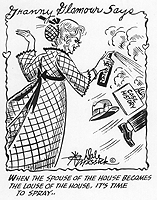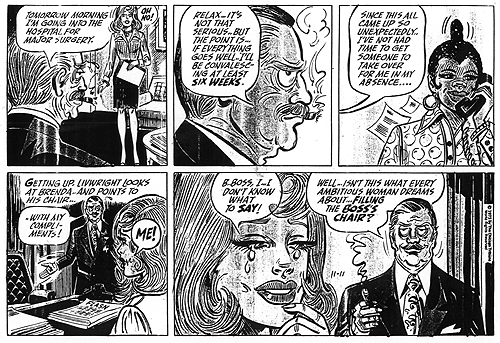Brenda Starr is an American icon. Jackie Leger looks at the woman behind her and the long legacy of female comic strip artists, who are unfortunatly not quite as well known
Dale Messick, America's first woman syndicated comic strip artist, is a celebrity in her own time. Creator of the legendary Brenda Starr, Messick worked hard to become what "herstorian," Trina Robbins considers to be "the most important woman cartoonist of the Twentieth Century." Dale Messick was witty and energetic when I visited her a few years ago at her Santa Rosa home to interview her for a documentary film I was making about her unique life. At that time, she was still drawing daily, creating a new comic strip, Granny Glamour, for senior citizens like herself and selling her work at local charity events. Dale's dedication to the art of cartooning, her success as an internationally acclaimed artist and her lively and off beat personality bestow on her the title of the First Lady of Funnies.

Finding Her Way to NYC
Her story began in 1906 in South Bend, Indiana where Dalia was born. Her mother was a seamstress and her father was an artist and sign painter who encouraged her to draw. Already drawing story-strips for her seventh grade class in Hobart, she always considered herself "a natural storyteller." Her ideas came from serial movies of the time with themes focusing on the lives of nurses and the dilemmas of World War I, saloons, dance halls, Germans and other subjects which would mark her work and that of other female comic strip artists in the 1920s. Dale didn't like high school finding it "dull" but after graduation, she continued her studies at the Ray Commercial Art School in Chicago. Her first job was working for a greeting card company for $10 a week. Her talent and innovative ideas, however, let her hop to another greeting card company and then another until she was earning about $35 a week. When one of her cards sold a bumper-crop of copies and she didn't receive a bonus; she quit and bravely moved to New York City in 1934. She was never poor from that day on. She worked for another greeting card company which gave her enough security and inspiration to work on her comic strips at night. When she was ready to show her portfolio, she had eight strips to her name and a lot of hope despite the fact that the world of comic strip art was a male dominated profession.

A Rich History
The history of women in illustration and graphic arts is an interesting facet of American culture. In 1895, Rose O'Neill won a drawing contest in Nebraska which brought her to New York as America's first woman illustrator and soon to be creator of the famous, cute, innocent Kewpie. Other women followed and for years the pages of magazines like Harper's Magazine hired woman artists. They were best at drawing the cherubic children and angelic women needed for advertising everything from soap to Jell-O to soup and other products relating images of household bliss and economic prosperity. Women comic strip artists, however, were another breed. By 1901, comic strips by women appeared in the Sunday newspapers and popular magazines of the day, mostly catering to other women. However, many comic strip artists were not housewives presenting a view of home and family. Being single, working for a living and looking for a husband added a new dimension to their work. In Colorado, a young illustrator Nel Brinkley was working for the Denver Post for seven dollars a week before coming to New York to work for the Hearst Journal where she created The Brinkley Girls, a flapper fad which set the tone for the new independence influenced by Hollywood glamour and elegance. The Roaring Twenties ushered in images of beautiful women with fun loving spirits like "Flapper Fanny" and "Mopsy," who were designed by Gladys Parker. Independent Flapper female heroines touched the hearts of women across the country and these strips caught on enough to allow women artists to explore wit and humor in a new graphic context.
This image of freedom changed in 1929 with the Great Depression. The insecurity of the times put a damper on the free spirit of Flapperdom and focused on day-to-day problems. Throughout the 1930s and 1940s, social injustice, war, poverty and other political issues were showing up in comic strips giving women another challenge, to compete with their male counterparts. While women were expected to draw cute characters or family settings, they were rarely acknowledged as serious social commentators in the male dominated arena of comic strip art. To the surprise of many, Little Orphan Annie drawn by Edwina Dumm, one of America's first political cartoonists, became widely popular and set the mood for somber comics relating a wartime world. Dale Messick was also representative of her time, and armed with several strips, she changed her name from Dalia to Dale as a first step in competing for her place in the world of newspaper comics. Her first submission, "Streamline Babies" about two women who come to New York in search of fame and fortune, was rejected by the then popular McNaught Syndicate for a strip based on a radio play of Charlie McCarthy and Edgar Bergen. Dale was shattered but picked up the pieces and tried another project.
Enter Brenda Starr
Finding a syndicate to publish Brenda Starr, Reporter was extremely difficult. Armed with her new name and strongest portfolio yet, Dale Messick approached Joseph M. Patterson, publisher of the New York Daily News and head of the Chicago Tribune-New York News Syndicate. According to some, Patterson was considered the epitome of male chauvinism and wanted nothing to do with women cartoonists, having tried one once! Due to the grace of another woman, Mollie Slott who worked as a "Girl Friday" for Patterson, Dale had a fighting chance to show her work. While it wasn't accepted for the Daily News, Brenda Starr first appeared in the Sunday comics beginning in June 1940. It wasn't until after Patterson's death that the strip was actually featured in the Daily News.
Brenda Starr became one of the most successful comic strips ever and for Dale, Brenda Starr's life, adventures and clothes were a successful formula; they were all things that the average housewife wanted to have. Dale remained true to the soap opera value of her heroine, keeping the adventure well balanced with fashion and romance. Over the years, Dale has taken harsh criticism from hard-core female reporters for making Brenda Starr too well dressed or too focused on "capturing" the handsome Mystery Man to be serious about her job. Dale defends her character with passion. To this day, she firmly believes that Brenda is a perfect balance of an ideal reporter and says that, "Authenticity is something I always try to avoid." Dale, a product of her era, knew that the '40s were a depressing time and she wanted to create a character to capture the imagination of women everywhere.

A Cultural Icon
By 1942 America was steeped in war and with men of draft age joining the service, women took their place in the work force. During this drab and uncertain time, the need for female-based comic strips tripled and for one brief moment in time, women blonde bombers to girl commandos battled enemies and lived a high flying life of adventure and daring. By putting Brenda Starr parachuting from planes or nearly freezing at high altitudes in exotic places, she was changing the dreary life of the American working girl. And, what good is adventure without romance? World War II saw American men volunteering to fight Fascism overseas and movies, pulp fiction and comic books reflected the action-oriented theme of war. As early as 1937, an issue of Adventure Comics had illustrator Cecelia Paddock Munson signing The Monastery of the Blue God, a spy story with intrigue. A few years later, Tarpe Mills was drawing one of her best action strips Daredevil Barry Finn, later Miss Fury. Best of all, almost from the beginning, comic books were employing women.
Dale Messick was in the right place at the right time, as red-haired Brenda Starr emerged as an eager female reporter for the Flash, with its first "team" of colleagues to include Tom Taylor (crack cameraman in love with Brenda), Pesky Miller (copy boy), Daphe Dimples (boss's niece) and Muggs Walters (boss and editor of the Flash, later changed to Mr. Livwright). Brenda Starr had spunk and wanted to escape social tea journalism for the quest of exciting stories in out of the ordinary places.

When the war ended, women were encouraged to return to the kitchen and family life. As the 1950s arrived, a new period of security brought with it wit, humor and a new generation of sassy, gum chewing teenagers, a far cry from the working girls preceding them. While Dale Messick produced several strips, only Brenda Starr reached international acclaim. Her themes of independence, daring and quirkiness always reflected the issues of her day and her own personality. She remains the last living witness to the Golden Era of Comics.
A Lasting Legacy
Today, Brenda Starr has been taken over by Ramona Fradon who had her first comic job at DC Comics working on male action heroes like Batman and Superman. She replaced Messick in 1980, upon her retirement. Women in comics need a forthright and enduring spirit and while Dale's comic strips were never made into animated films, two feature films based on Brenda Starr, one for ABC starring Jill St. John and another produced by New World starring Brooke Shields, were made.

Looking back on her long career, Dale's content with her success yet regrets that she's still not 100% accepted by her male counterparts. She paved the way for the new generation of action heroine strips yet male comics still rule. When asked about the key to her success, she says that she never copied other comics but tried to use her own imagination in all her stories. Her method of working was dedication and she still receives fan mail from her readers, who are mostly female fans. In the cast with Brenda Starr was the Mystery Man, Basil St. John, whom she eventually wed to an array of newspaper articles and national hoopla. Brenda Starr became a role model for a generation of young female readers inspired to enter the newspaper field or pursue independent careers. For this, Dale Messick will always be remembered.
In our last interview, Dale mentioned that she always wanted to be somebody, to be recognized. She has achieved this goal. Hard work has always been her formula for success, and at age 94, her life is far from boring. She showed me the gym where she works out and gave me a Christmas card with a photograph of herself on a brand new Harley. "It's not mine," she laughed! Back at the drawing board, her strip for seniors is gaining popularity. Dale Messick is truly a pioneer and inspiration for woman cartoonists everywhere.
Jackie Leger is a Santa Monica, California-based writer specializing in independent animation.








